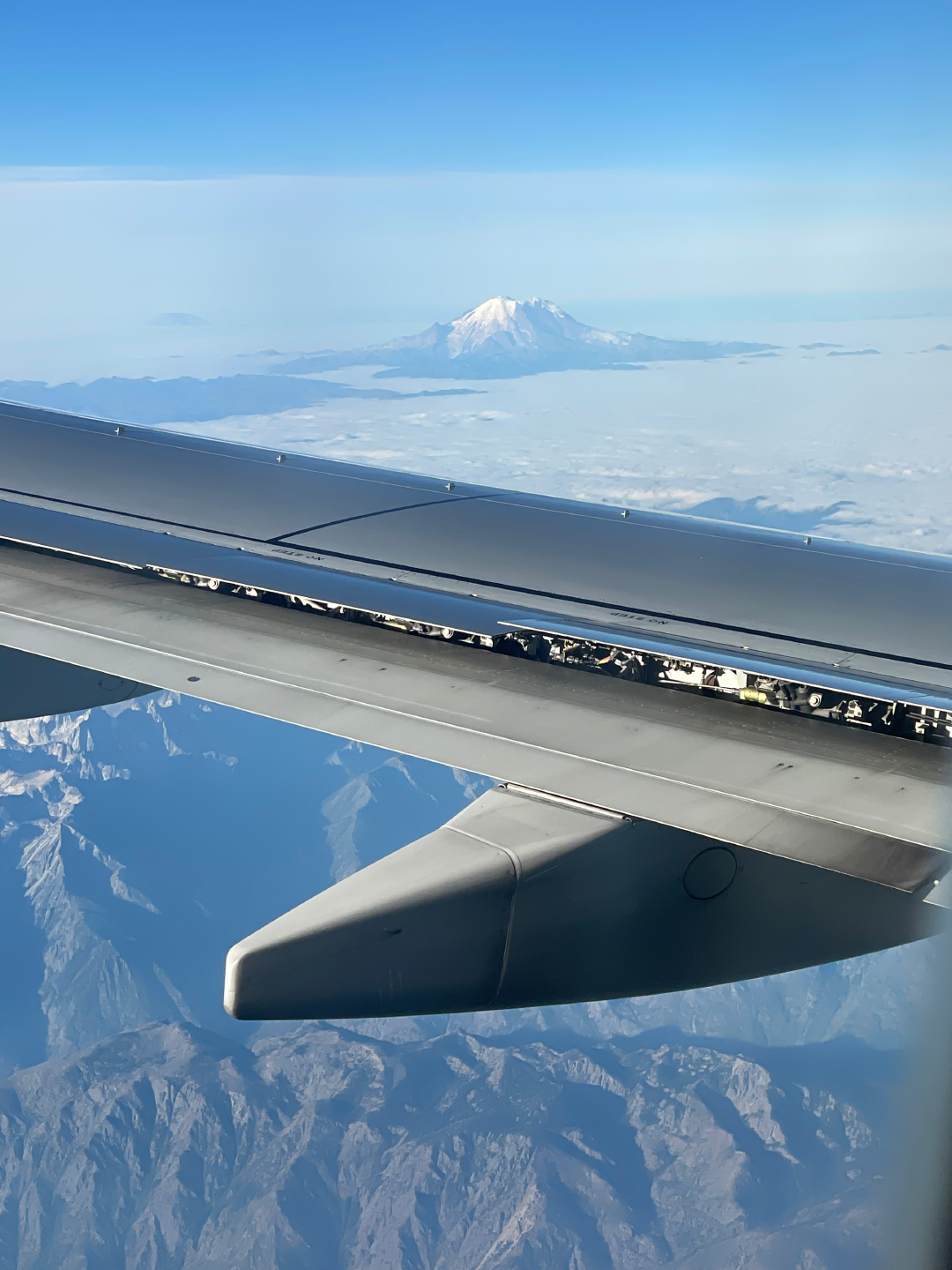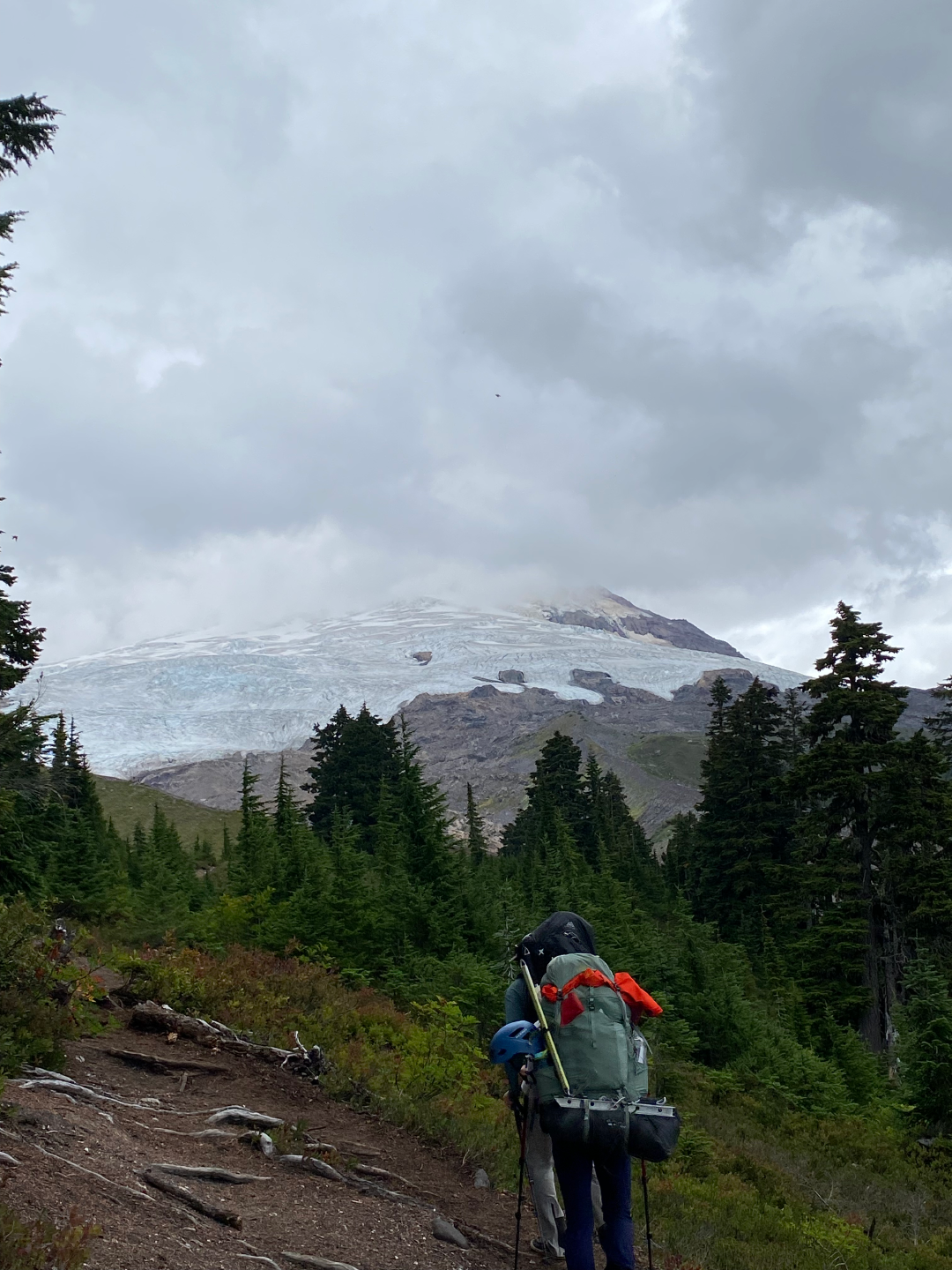In early September, we embarked on a vacation trip with the lofty goal of conquering the imposing snow-covered giant, Mount Baker, standing tall at 10,786 feet at its most technical time. I approached it with casual enthusiasm one might have for trying out a new sport at the beach. My initial aim was simply to acquaint myself with the world of snow-clad peaks. Little did I know that our expedition would turn into a technical climbing adventure, demanding both ascent and descent on a daunting 200 to 300-foot, 35-40 degree slope of translucent ice and rock combo. Recent hot weather had done no favors to the precarious Roman Wall, with only a single successful summit recorded in the past two weeks. The words of our guide, Don, still echo in my ears: “Just don’t fall.”
On the day of our summit attempt, we found ourselves spending a grueling 8 hours and 39 minutes traversing glaciers and snowfields. In the initial hour, our guide’s concern of our footwork was palpable as we navigated treacherous terrain. The Roman wall, characterized by its icy and muddy surface, allowed no margin for error. A misplaced step could spell disaster for our entire team with a guide-to-climber ratio of 1 :3. As we neared the crater and the Roman Wall at the third rest stop, we held onto our ice axes, abandoned our trekking poles, and shortened our rope from 9 meters to a mere 2 meters in preparation for the ascent. At that moment, I had no inkling of just how formidable a challenge the 35 to 40-degree icy wall would prove to be.
Ascending Roman Wall
After a brief rest, we commenced our ascent, traversing through areas where rocks occasionally tumbled down, all the way watching Don diligently maintain the flags. In the initial stage of scaling the wall, which comprised the first half of our climb, it appeared exactly like a typical snow-covered slope. The steep incline began to take a toll on my left leg, causing some discomfort and stiffness, but it remained within manageable bounds.
Things took a technical turn as we reached the midpoint of the wall. Icy translucent surfaces, trickling water, mud, and scattered scree became the new terrain. Each step required precise placement on a flat surface or anchoring into the wall using crampons. As a precaution against potential accidents, we carried an extra sleeping bag for waiting of rescue. Guided by Don who skillfully broke the ice, we progressed steadily in zigzag patterns by mimicking his exact footsteps. Additionally, I held the rear position on our rope team. Everything seemed well under control. However, a lingering question began to form in my mind: What would be our descent strategy? Yet, this thought quickly dissipated as I refocused on my footwork.

Illustration of the Roman Wall climbing routes. The red line indicates the most technical challenging part of the trip (Image generated with Fantasy World Generator API, no photos for the wall).
After completing approximately six zigzags, we successfully navigated through the most technically challenging section of the wall. We stepped onto a path resembling a sidewalk, a softer scree slope, and continued our ascent to a flat platform that offered a clear view of the summit of Mount Baker. Our excitement surged; the summit, our ultimate destination, now lay tantalizingly close.
Summit
We extended the rope length back to 9 meters to prepare for potential crevasses and continued our march toward the summit. Don had been expressing concern about our insulation layers from the very start of our journey at the trailhead. We were equipped with only two thin insulation layers, which might not have been sufficient to withstand the typical cold and windy conditions at the summit. In preparation, he even brought along an extra puffy jacket as a precautionary measure. Fortunately, it remained unused. The temperature at the peak, as per the forecast from two sources, was hovering around a relatively mild 2 degrees above freezing, with a gentle breeze of less than 15 mph. We had set out from our camp around 8:30 am to have the best temperature.
You might wonder why we initiated our summit attempt relatively late in the day. Don had gathered valuable insights from his friends and from studying the mountain itself, ultimately making the decision the night before the summit. Ordinarily, climbers tend to start their ascent in the early hours of the morning to catch the sunrise, secure better visibility, and avoid potential weather hazard in the afternoon. However, given the icy conditions of the Roman Wall, which was essentially a frozen 200 to 300-foot, 35 to 40-degree ice wall, it would have been extremely challenging to traverse it in the frigid pre-dawn hours. It made more sense to tackle the wall after it had a chance to thaw slightly, which facilitate both the ascent and descent. This approach ensured a somewhat warmer temperature at the summit. Additionally, Mount Baker had stable weather. This was my rationale.
At 2:20 pm on September 9, 2023, we triumphantly reached the summit of Mount Baker, standing tall at 10,786 feet, at what proved to be the most technically demanding period of the season. We snapped photos together and took in the awe-inspiring panoramic views, savoring every moment. This ascent marked our inaugural mountain conquest, and we lingered at the summit for approximately 10 minutes before embarking on our descent.
Descending Roman Wall
Being the last person in the rope team, I WOULD LEAD THE WAY DOWN THE ROMAN WALL! Don, positioned at the rear instead, oversaw our direction and offered immediate advice as needed. We shortened the rope and began our descent down the Roman Wall.
My initial plan for the descent was to trace the footsteps Don had left behind about an hour ago, zigzagging our way down the icy slope. Unfortunately, the scorching weather had erased most of them, leaving us struggling to find those faint traces. Moreover, I didn’t fully trust the remaining footprints. To combat this, I cautiously tested each step by tapping my feet multiple times, creating new footholds slowly and with great care. This meticulous approach made our descent less efficient and prolonged our exposure to potential hazards.
There was one particularly sketchy spot where my confidence faltered momentarily, and I almost gave in to the impulse to sit on the slope. However, I quickly reminded myself that such a move was far too risky on this icy wall. Both Don and my inner instincts urged me to stay upright and use logic to combat my fear. Don also provided real-time corrections to our footwork, emphasizing the need to strike with strength at an angle into the ice with normal distance, which boosted my confidence and comfort. Despite the correct footwork and mindset, it took several attempts to adapt to moving in different directions —left, right, diagonal, and down. Nevertheless, we managed to navigate it successfully. My intense focus on the task at hand left no room for fear of heights. I observed Don confidently moving around as if it were a sidewalk, and I now understand why he had referred to our training walk on snow and glacier as a “sidewalk” during the training sessions. He was even wearing leisure shoes for the entire mountain hiking route, as if we were strolling around in slippers at home.
Following the flags marking our path, we continued our zigzagging descent down the Roman Wall. At times, Don asked us to pause and add or adjust flags to assist future climbers who aimed to reach the summit. This act was also a way for him to pay back to his friends who had placed these flags, as he mentioned upon our return to the main camp. Their team had successfully summited just two days earlier, an achievement that had eluded other teams for the past two weeks. Don meticulously tended to the flags all the way down to the base camp, ensuring they were secure, much like adding a protective layer of snow on top to prevent them from melting and placing flags near new fragile snow bridge above crevasses.
Path over Crevasses
At last, we descended from the Roman Wall, and that’s where things took a turn for the better — it felt like walking on soft mashed potatoes. We carefully maintained a 9-meter distance to navigate around potential crevasses. We briskly moved through an area known for falling rocks, and we even heard one tumble just before reaching it. When it came to ascending, we made four rest stops, while descending, we only took one to retrieve our trekking poles, eager to reach camp for a much-needed rest and to share our summit experience with friends at the internet cafe we discovered near our tents. Nevertheless, our guide, Don, remained cautious due to the heat, which paid off as we discovered several paths we had used for ascent were now over new crevasses. Don added warning flags and dug holes to alert future climbers in the coming days.
Leisure Time
We reached our campsite at approximately 6:50 pm. Don offered us some recommendations on our next-climbing adventure, taking into acount our skills and the techniques we’d honed. It seemed like the logical choice would be Mount Rainier, the one we saw on the airplane, as it’s less technically demanding than today’s climb on Mount Baker but presents a greater physical challenge. He also recommended one book each new climber should read — Mountaineering: The Freedom of the Hills.
After a hearty meal, we anticipated a restful night’s sleep, but our excitement proved too overwhelming to get any rest. It is a tranquil night, with no wind and a clear view of the Milky Way. Here are some pictures we captured near our campsite.


















